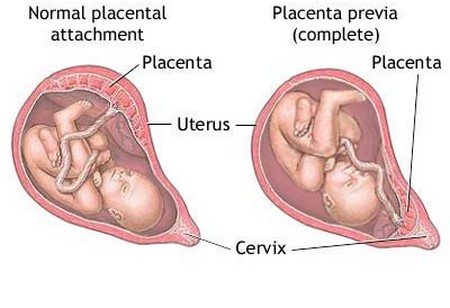Best Way to Deal with Placenta Previa during Pregnancy
Your placenta supplies the baby with nutrients through the umbilical cord. In most cases, the placenta attaches to the upper wall of the uterus. If you’re diagnosed with placenta previa, your placenta is developing low in the uterus, where it can be easily damaged. In some cases the placenta starts off low in the uterus but as the lower segment of the uterus expands, the placenta is in a higher position and is no longer a potential source of trouble for your pregnancy.
There are often no symptoms of placenta previa. It may be discovered by chance during an ultrasound exam, or occasionally there is painless bleeding from the vagina, usually late in the pregnancy. Bleeding at any time in your pregnancy should be reported immediately to your OB provider.
Most women with placenta previa have only a little vaginal spotting or bleeding. However, if you have heavy bleeding because of this condition, you may hemorrhage; that is, lose a dangerous amount of blood. Hemorrhaging also deprives your baby of oxygen. You may need blood transfusions, and your baby may need to be delivered quickly.
Placenta previa occurs in about one out of 200 pregnancies and is rare in first pregnancies. If you have had cesareans or other abdominal surgery or are carrying multiples, you’re more likely to experience placenta previa.
There are three types of placenta previa:
- A complete previa means the placenta is completely over the cervix. A complete previa will require cesarean delivery because the baby cannot pass the placenta and the pushing and pressure of the baby’s head will cause significant bleeding.
- A partial or marginal previa means the placenta is partially covering the cervix. This kind of previa needs to be evaluated by the doctor at the time of delivery but many times the baby is delivered by cesarean.
- A low-lying placenta means the placenta is near the opening of the cervix. This condition only becomes a problem when the baby cannot move down into the birth canal without causing trauma to the placenta and thus bleeding.
Treatment for Placenta Previa
Even with very little bleeding or spotting from the previa, your doctor will have to monitor you very closely. This will mean frequent sonograms to check on the position of your placenta. Cervical exams are limited because they can provoke bleeding. You will be restricted from having intercourse. If the placenta is only covering the cervix partially, you may be able to deliver vaginally.
If you have a complete placenta previa, you’re usually put on strict bed rest and you may have to be hospitalized for part of your pregnancy, especially if you start to have bleeding. When your baby is full term, you will probably be delivered by cesarean. The doctor may decide to perform the cesarean before your labor starts to avoid the possible complications of bleeding or to avoid an emergency cesarean.
Categories
Advertisements
Recent Articles
 How to Understand Bed Sizes – A Small Guide
How to Understand Bed Sizes – A Small Guide How to Select Some Must Have Kitchen Accessories
How to Select Some Must Have Kitchen Accessories Best Way to Change a Car Tire
Best Way to Change a Car Tire Best Way to Write an Affirmation
Best Way to Write an Affirmation Best Way to Take Charge of Your Financial Life
Best Way to Take Charge of Your Financial Life Best Way to Survive a Party When You Don’t Know Anyone
Best Way to Survive a Party When You Don’t Know Anyone Best Way to Stop Self Sabotaging Yourself
Best Way to Stop Self Sabotaging Yourself Best Way to Start Journal Writing
Best Way to Start Journal Writing Best Way to Speak with a Powerful Voice
Best Way to Speak with a Powerful Voice Best Way to Simplify Your Life
Best Way to Simplify Your Life Best Way to Respond to a Put-Down
Best Way to Respond to a Put-Down Best Way to Reduce Acne Breakouts
Best Way to Reduce Acne Breakouts Best Way to Recover from Dining Disasters
Best Way to Recover from Dining Disasters Best Way to Quit Your Job Gracefully
Best Way to Quit Your Job Gracefully Best Way to Make Your Own Website
Best Way to Make Your Own Website


Leave a Reply